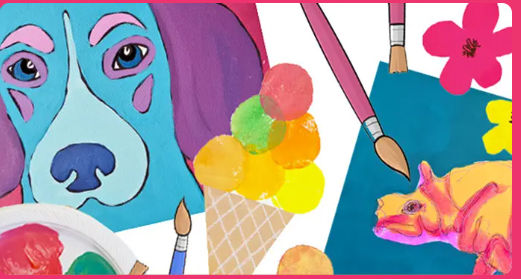
Art lessons for teachers are a powerful tool for fostering creativity, enhancing problem-solving skills, and promoting emotional expression among students. This comprehensive guide provides educators with essential strategies, innovative techniques, and practical tips to deliver effective and engaging art lessons in the classroom. By implementing these methods, teachers can create a dynamic learning environment that nurtures students’ artistic talents and boosts their overall development.
The Significance of Art Education
Art education is fundamental in shaping well-rounded, creative, and emotionally intelligent individuals. Here are some key reasons why integrating art lessons into the curriculum is crucial:
1. Enhances Creative Thinking
Art encourages students to think outside the box, explore different perspectives, and develop unique solutions to problems. This creative thinking is valuable across all areas of learning and life.
2. Develops Fine Motor Skills
Art activities such as drawing, painting, and sculpting help improve fine motor skills, hand-eye coordination, and precision.
3. Supports Emotional Expression
Through art, students can express their emotions, thoughts, and experiences in a non-verbal manner, promoting emotional health and resilience.
4. Fosters Cultural Awareness
Art lessons expose students to various cultures and historical periods, broadening their understanding and appreciation of diversity.
5. Boosts Academic Performance
Studies have shown that students engaged in art education tend to perform better academically, as it enhances critical thinking, problem-solving abilities, and attention to detail.
Designing an Effective Art Curriculum
Creating an effective art curriculum involves strategic planning and a deep understanding of educational goals. Here are essential steps to develop a comprehensive art program:
1. Establish Clear Learning Objectives
Define specific skills and knowledge you want your students to acquire. Objectives could include mastering different art techniques, understanding art history, and developing critical analysis skills.
2. Diversify Art Mediums and Techniques
Incorporate a variety of art forms to cater to different interests and talents. This could include:
- Traditional Media: Drawing, painting, and sculpture.
- Digital Art: Graphic design, animation, and photography.
- Crafts: Textiles, jewelry making, and paper crafts.
3. Integrate Art History and Criticism
Teach students about significant art movements, renowned artists, and historical contexts. Encourage them to analyze and critique artworks, developing their critical thinking and appreciation for art.
4. Plan Interactive and Collaborative Projects
Design activities that involve group work, discussions, and peer reviews. Projects like murals, exhibitions, and collaborative installations can enhance teamwork and communication skills.
5. Implement Regular Assessments
Use a combination of formative and summative assessments to gauge student progress. Portfolios, self-assessments, and peer reviews are effective tools for evaluating artistic growth and development.
Innovative Art Lesson Ideas
Here are some creative and engaging art lesson ideas that can inspire and motivate your students:
1. Self-Portrait Exploration
Have students create self-portraits using various mediums. This activity helps them explore identity, self-expression, and artistic techniques.
2. Environmental Art Projects
Encourage students to create artworks using recycled materials. This promotes environmental awareness and creativity in finding new uses for discarded items.
3. Thematic Art Collections
Organize projects around specific themes such as nature, emotions, or historical events. This helps students connect their art to broader concepts and ideas.
4. Art and Technology Integration
Incorporate digital tools and software into your lessons. Students can create digital paintings, animations, or graphic designs, enhancing their technical skills and creativity.
5. Cultural Art Studies
Explore different cultures through art. Have students create pieces inspired by traditional art forms from around the world, fostering cultural understanding and appreciation.
Effective Teaching Strategies for Art Educators
To maximize the impact of your art lessons, consider these effective teaching strategies:
1. Foster a Positive Classroom Environment
Create a supportive and inclusive atmosphere where students feel comfortable expressing themselves and experimenting with new ideas.
2. Encourage Creative Risk-Taking
Promote an environment where students feel safe to take risks and learn from their mistakes. This is essential for their artistic growth and confidence.
3. Differentiate Instruction
Recognize and address the diverse needs of your students. Provide tailored support and challenges to accommodate varying skill levels and learning styles.
4. Utilize Visual Aids and Resources
Incorporate visual aids, demonstrations, and multimedia resources to enhance your lessons. Step-by-step guides and video tutorials can be particularly effective.
5. Connect Art with Other Disciplines
Integrate art lessons with subjects like history, literature, and science. This interdisciplinary approach makes learning more relevant and engaging for students.
Professional Development for Art Teachers
Continuous professional development is crucial for staying updated with new teaching methods and art trends. Here are some ways to enhance your professional growth:
1. Attend Art Education Workshops
Participate in workshops and seminars to learn new techniques and strategies. Networking with other art educators can provide valuable insights and inspiration.
2. Join Professional Organizations
Membership in organizations such as the National Art Education Association (NAEA) provides access to resources, support, and professional development opportunities.
3. Take Online Courses
Enroll in online courses focused on art education. Platforms like Coursera, edX, and Khan Academy offer a wide range of courses that can enhance your knowledge and skills.
4. Collaborate with Colleagues
Work with fellow teachers to share ideas, resources, and best practices. Peer observations and collaborative planning can improve your teaching methods.
5. Stay Informed About Art Trends
Keep up with current art trends by following art blogs, attending exhibitions, and subscribing to art magazines. This helps you bring fresh and contemporary ideas into your classroom.
Conclusion
Incorporating effective and engaging art lesson for teachers can significantly enhance students’ educational experience. By fostering creativity, encouraging critical thinking, and promoting cultural awareness, art education plays a vital role in the overall development of students. Utilize the strategies and techniques outlined in this guide to create a dynamic and inspiring art curriculum that will captivate and motivate your students.
